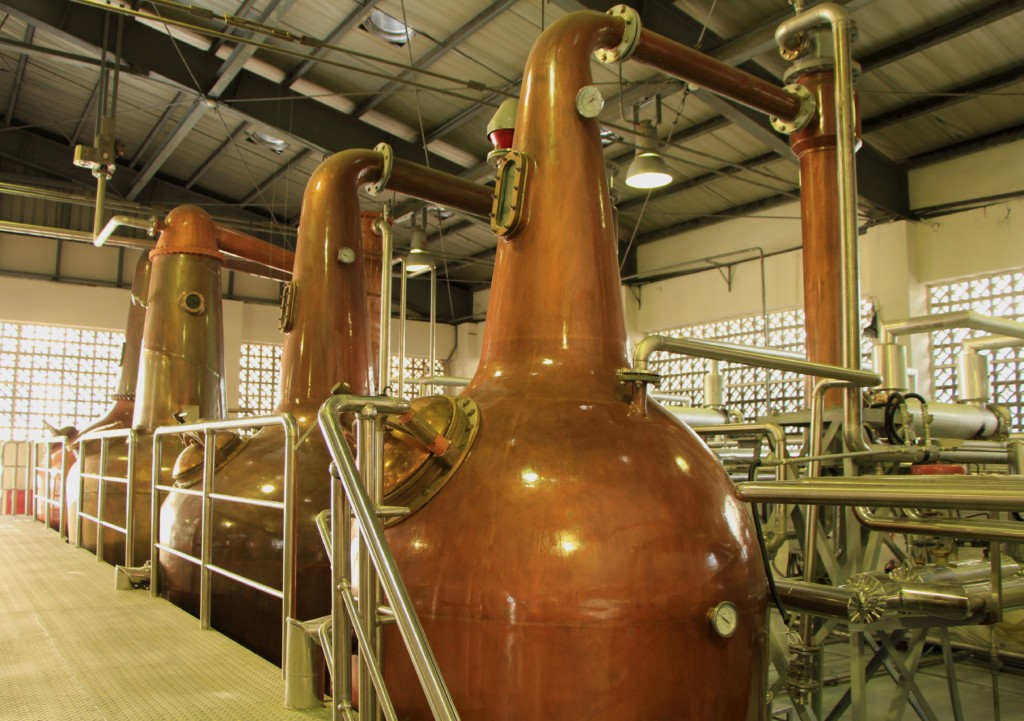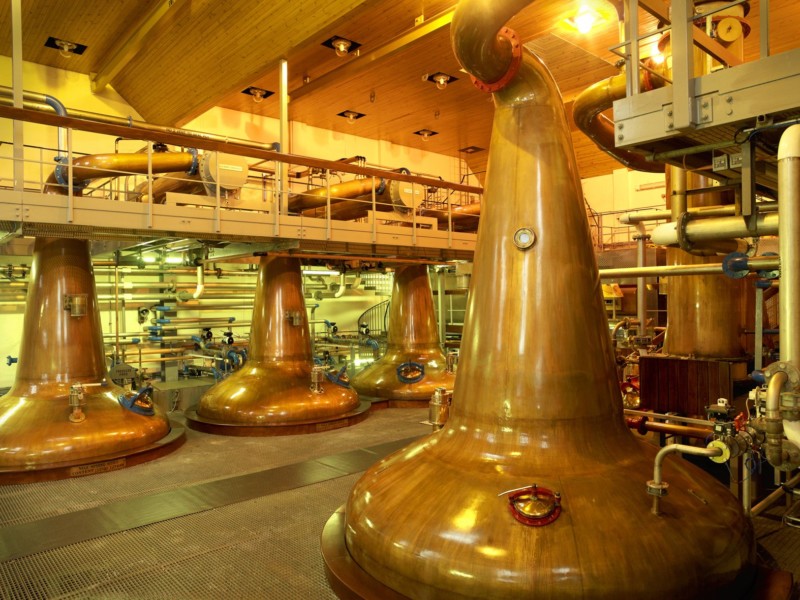At the heart and soul of a distillery, and one of the most important parts of the whisky making process, sits the stills!
Those beautiful bulbous cauldrons boiling away with malted magic inside just waiting to vaporise and become liquid again, working to create a spirit that one day will become whisky!
Truly a sight to be seen for any whisky lover! Distillation is where the alcohol from the wash is concentrated, and where the volatile components are extracted in order to create a new make spirit. In Scotch whisky making, pot stills and column stills are both used, and this guide will simplify the basic functions of both types of distillation.
Distiller’s Beer:
Before the stills can be fired up, there must be alcohol to distill! Wash, or commonly known as “distiller’s beer” is what is created during fermentation. Yeast is added to the wort, or the liquid that is drained from the mashing process of grist and hot water and is fermented in either wooden or stainless steel washbacks (big tanks, so to speak). Fermentation times can be anywhere from 48 hours (short) to 60+ hours (long). A short fermentation produces more cereal, nutty like flavours, where longer fermentations produce more estery and fruit forward flavours. The distillers beer is typically around 8-10 % ABV.
King of the Batch:
Now, the fun begins! Throughout history, pot stills have been the most commonly used still in crafting top quality distilled spirits. To make single malt Scotch whisky, one must use a pot still. Made of copper, they run on what is known as a batch process, simply meaning that after a run of alcohol is distilled, the leftover liquids are drained and the still is washed and charged with a new batch. In Scotch whisky production, two types of stills are used to create new make spirit – the wash still and the spirit still – which results in the spirit being distilled a minimum of two times. First, the wash, or distiller’s beer is pumped into the pot of the wash still and is heated by way of steam jacket (a lining on the outside of the still that heats it up), a coil inside of the pot of the still, or by direct flame underneath the still. Think of it like a giant kettle, heating up a tasty brew!
The wash still is typically larger than the spirit still and will sometimes have a sight window so you can see the frothy waves crashing about inside. As the wash inside begins to boil, the ethanol is vaporised, as alcohol boils at a lower temperature than water, and rises up the neck of the still. It then reaches the Lyne arm, a slightly sloping pipe that connects the head of the still to the condenser, where the vapours are turned back into a liquid. From there, the liquid known as ‘low wines’ which is usually around 20-25% ABV, is distilled a second time in the smaller spirit still. After the vapours are condensed in the spirit still, they are sent to the spirit safe where they are separated into three parts, or ‘cut points’ by the distiller:
- Foreshots (heads):this includes the first run of liquid from the condensers and is undesirable due to being harmful to your health, as well as tasting horrible! This liquid is sent to a feints receiver to be collected for re-distillation in the next batch.
- Spirit (hearts): Ah, the new make! After the foreshots, the new make emerges, and the distillers will collect this in a separate tank to eventually become Scotch whisky.
- Feints (tails): This is the weighty liquid, full of the heavier not so desirable liquids. It too goes to be collected with the foreshots for the next run of low wine distillation.
The hearts are then sent off to rest in casks for at least 3 years and can then be called Scotch whisky!

Keep it Moving:
Now that we know the process of batch distillation, let’s dig into continuous distillation! Column stills are used to distill grain whisky in the world of Scotch whisky but are very often seen throughout the world to make vodka, rum, bourbon and more. As the name implies, this type of distillation runs continuously. The wash (which is not filtered prior to distillation, so all the chunky bits go in too!) enters the column via a pipe at the top and weaves its way down a series of perforated copper plates before making its way to the bottom where steam heats the wash. Here, the solids exit the system, and the alcohol vapours rise up through copper trays of a second column known as a rectifier, with the heavier compounds being left on the plates. The lighter compounds rise to the top to be condensed back into a liquid, which becomes the grain new make spirit. Column stills provide the benefit of efficiency, as they can literally run day and night, without having to be washed and recharged in between batches. They are easier to maintain, as they are typically made from stainless steel, can create distillate with a higher ABV, and are more economical to run. We typically see these types of stills in grain distilleries in Scotland but they can be found in many corners of the world including Japan, The United States and Canada.
Which is best?
I’m not sure that’s a question that can honestly be answered. While pot stills create a full bodied and meatier spirit, and column stills lean towards a lighter and cleaner spirit, both craft incredible whiskies! One is not easier than the other, they are just different, and both vital to the whisk(e)y world, providing us consumers with an array of flavour and variety. Sure, I do love an oily, gritty and hearty pot still whisky, but I too definitely enjoy a lovely crisp blended malt or grain whisky that hails from the tall steel giants. Dare I say one is better than the other? No, that is something I feel could never be answered as whisky is an ever moving target, never being able to be placed in a box of “favourite or “best”. Every single day a new soon to be whisky is being laid down that has nothing but potential ahead of it, and whether it comes from a pot still or a column still, I’m looking forward to having it in my glass.
If you would ever like a recommendation of a pot still or column still whisky from The Scotch Malt Whisky Society, please reach out to me, as I am am always happy to share my love of both with you and help find a great dram for you to enjoy!
—
This Battle Royale article was written by Jenna Elie from SMWS America and repurposed in-kind. You can check out our currently available column-distilled grain whisky on our site here.








